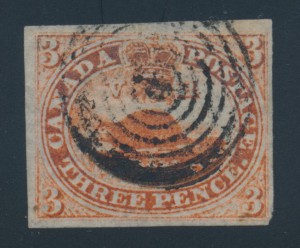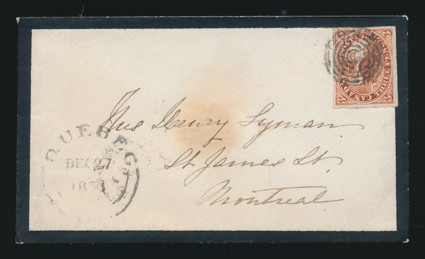 Lot 1703 Canada #4vii 1856 3d deep red Beaver with Major Re-Entry on Cover. Stamp has four margins, with very clear pos. 47 re-entry and is tied to lovely mourning cover sent Québec DEC.27.1856 to Montreal same day arrival on back. Light stain on front caused by wax seal on back, else very fine and scarce. Accompanied by 1984 Greene Foundation certificate on which it is written in pencil that this was lot 587 in Maresch sale 168/69 which then sold for $1,600 plus 15%. Ex-Cantor. Unitrade CV$1,800
Lot 1703 Canada #4vii 1856 3d deep red Beaver with Major Re-Entry on Cover. Stamp has four margins, with very clear pos. 47 re-entry and is tied to lovely mourning cover sent Québec DEC.27.1856 to Montreal same day arrival on back. Light stain on front caused by wax seal on back, else very fine and scarce. Accompanied by 1984 Greene Foundation certificate on which it is written in pencil that this was lot 587 in Maresch sale 168/69 which then sold for $1,600 plus 15%. Ex-Cantor. Unitrade CV$1,800
three penny Beaver
The Ken Kershaw Collection Of Nepal & Tibet
As a schoolboy Ken Kershaw was able to demonstrate an encyclopedic knowledge of all British flora. His scholarship and phenomenal memory served him well in his academic career. Field trips around the world, and especially in the Arctic, led to his publications on lichens which have set a scholarly gold standard.
After early retirement his natural curiosity and training in study and classification served him well as an entrepreneur and later as a restaurateur.
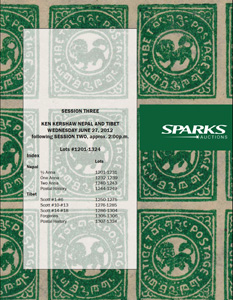 A return to his boyhood hobby has resulted in about a dozen research books, notably the five volume study of Canada’s Three Penny Beaver. Ken is intrigued by difficult philatelic problems. He enjoys the challenge of first identifying and then confirming a plating study. Nepal and Tibet introduced the problem of confirming printing flaws as constant, progressive, or non-constant. To do this he obtained as many large blocks and sheets from as many settings as was practical. Although Ken is still working with the pashupati issues the time has come to move on to other pursuits.
A return to his boyhood hobby has resulted in about a dozen research books, notably the five volume study of Canada’s Three Penny Beaver. Ken is intrigued by difficult philatelic problems. He enjoys the challenge of first identifying and then confirming a plating study. Nepal and Tibet introduced the problem of confirming printing flaws as constant, progressive, or non-constant. To do this he obtained as many large blocks and sheets from as many settings as was practical. Although Ken is still working with the pashupati issues the time has come to move on to other pursuits.
NOTES ON THIS AUCTION
Especially in the case of Nepal, the native laid paper has characteristic inclusions and lack of uniformity such that there may be no stamp in existence that merits the most exacting quality standards of some collectors. We have tried to describe all faults which occurred after manufacture as well as the grossest of the faults during manufacture of this paper. A grade of very fine was used when it occurred to us that a particular sheet or block had better than normal overall appearance.
Nepal is organized by denomination. Tibet is organized by Scott number. We refer to tete-beche stamps as inverts, a term which is more commonly used in the literature of the “Himals.”
Ken’s unpublished five-volume study THE HALF ANNA ISSUES OF NEPAL consists of more than twelve hundred pages of careful documentation of the Nepal issues. These books can be downloaded below and then read on your computer, eReader, or tablet device.
VOLUME I: The settings, definitive flaws, and plating criteria (11MB)
VOLUME II: Plating the flaws in the spandrels and central oval frame (30MB)
VOLUME III: Plating the frame flaws (19MB)
VOLUME IV: Plating the flaws in the central oval (10MB)
VOLUME V: Plating the flaws correlated with the double Khukris (15MB)
Lot 23 — Canada #4c used with partial imprint, sold for $862
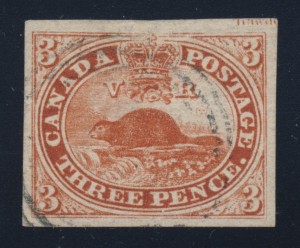 Canada #4c 1852 3d red beaver on soft ribbed paper, used with a lightly struck postmark, huge margins all around showing a portion of the plate imprint at upper right, extremely fine. Accompanied by 1974 BPA certificate. A lovely example of this stamp which is rarely encountered in premium condition. Unitrade CV$750, realized $862.
Canada #4c 1852 3d red beaver on soft ribbed paper, used with a lightly struck postmark, huge margins all around showing a portion of the plate imprint at upper right, extremely fine. Accompanied by 1974 BPA certificate. A lovely example of this stamp which is rarely encountered in premium condition. Unitrade CV$750, realized $862.
Certainty and Certificates
The great majority of all stamps can be identified with certainty. When one comes across a stamp which raises questions, however, certainty is often difficult. Questions may concern the catalogue number, whether genuine or not, with or without original gum, with or without postmark, evidence of alterations or repairs, etc. A certificate from a recognized authority can often answer these questions. Certificates are prepared by humans, however, and mistakes can be made between a determination of genuine and not (in either direction!).
Generally speaking one should prefer an opinion which is unequivocal — “is genuine in all respects” or “is a forgery” usually settles the matter. “Appears genuine as far as one can tell” or “no opinion” does not help much. Whole books have been written on the subject.
With this background in mind, we’ll look at two lots in our current auction. Both have certificates from the VG Greene Foundation which is the pre-eminent expert committee for the stamps of Canada and British North America.
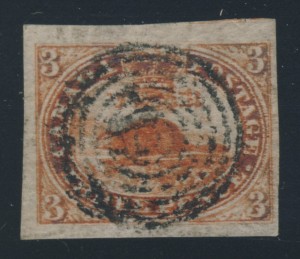
1851 3d red Beaver on laid paper, used with three jumbo margins and fourth well clear of outer frameline. 1978 Greene Foundation certificate mentions a “small hole” which is a pinhole not on this stamp, or in the margin but in the portion showing the next stamp at top right. A very fine example of Canada’s first stamp. Unitrade CV$1600.
A careful reading of our description explains how we interpret the rather unflattering description reading “small hole.” This is an example of a harsh Certificate. A Certificate which might be ambiguous about whether the gum is original would be an example of a generous Certificate. Generally speaking, the Greene Foundation is more likely to give a harsh rather than a generous Certificate.
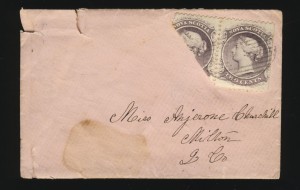
1860 2c lilac, pair one bisected on cover From a new find, backstamped Liverpool, NS APR.22.1868. As the Large Queen issue was introduced in April 1868, many postmasters wished to use up the old Nova Scotia stamps. Three cents was the new Dominion rate. In 2010 the Greene Foundation wrote “the item could be genuine but the lack of a cancel tying the bisect line to cover prevents us from giving an opinion.” Not noted by the Greene Foundation was the lack of evidence of a scoreline in the event someone has used a scalpel or knife to create a bisect and also a faint staining which ties the bisect to the cover. Envelope has a stain and is damaged in upper left and lower left corners. Both stamps have some damage. Unitrade CV$3500.
Here is another example of a lot where we added commentary to the description. I concur with the opinion of perhaps the foremost authority on Nova Scotia postal history that this is genuine. Both of us have examined it thoroughly and have the oral evidence of it being a new find (see also Lot 1269). An April 22 date (the new Dominion stamps were first available April 1) and the fact of a 50% increase in postage at the same time for an in-county Nova Scotia letter suggests that no respectable and frugal correspondent would voluntarily put two of his old colonial stamps on a letter.
However all that background is lost once this envelope changes hands several times. The faint stain which ties the bisect is evidence when the envelope first surfaces but hardly evidence decades from now. The Greene Foundation did not err with its “no opinion.”
For some items a collector has to live without absolute certainty.

